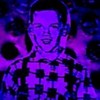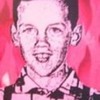---Or, Daddy-D. & Hatches, "We tell ourselves stories to keep ourselves alive," says Joan Didion, as quoted in an intro to a "quasi-fiction" American queer "best of" anthology featuring the work of David Wojnarowicz ...
by Brian Bouldrey ---Goblin, for thee I have done mass research and have compiled a "DW" file of information for this topic some 40 pages in length ... It is too much for any one person to take in one night. So I will be adding links to names and places throughout this topic, as well as the rest of the posts, in the days and weeks to come. Amazing that I had never heard of this person until Doug came along (and Hatches, subsequently, "clued" me in) ... for I have discovered layer upon layer of inter-active, multi-media realms online where David can be found these days.
Sidestepping all the obvious info needing posting - i.e. his books/works for sale, galleries/museums which catalog his work or plan exhibitions, biography information, places where his art/voice/likeness is continually being reinvented and reproduced, etc. There were two things that I came upon that I personally enjoyed discovering.
The first:
Jon's Homepage - Whoever Jon is, and whatever his Rubik's (or Rimbaud's) cube is about, I'd love to know ... I did not have the nerve to access the video cam, so, if someone else does, PLEASE! let us all know what happens ... that Tinkerbell scared me away ...
The second: The below article that starts with "the era" and "climate" of David and moves rapidly through the last few decades of New York Art Culture - living it, learning it and lumping it. I found the piece to be fodder so to speak for the ArtMaker forum on the whole, as well as a boat load of names and places for me to make links to (thus to find out what can not yet be found on the search engines about DW, and the rest of the "nuts and bolts" and "bags of tricks," that will eventually be the "product" of this forum.)
------------------------------------------------
Dual Nature. ArtForum: October, 1999.
by Peter Nagy. (artnet.com Nagy bio) - Even in the midst of the thrill of it all, it was apparent that two contingencies – one demographic, the other economic - laid the groundwork for the making of the "East Village Art Scene." First, the postwar baby boom, which peaked in 1959, led to an outpouring of art-school grads in the early '80s. Sometimes it seems as though a majority of my generation, having grown up in the fertile '60s, pursued careers in the creative arts, and the New York art world simply couldn't accommodate this glut of brash, snot-nosed artists eager to exhibit their goods, and consequently burst at the seams. Second, the boom market enabled a generation of artist-entrepreneurs not only to start their own galleries but to keep their doors open and flourish.
I graduated from Parsons School of Design in 1981, having majored in communication design and feasted on art-history and critical-theory courses in general. At the time, I was working as a typesetter in a small ad and magazine shop on West Fifty-seventh Street and one day Alan Belcher walked in to do pasteups and mechanicals. We bonded almost immediately over
Malcolm McLaren's latest project, Bow Wow Wow, and soon started going to galleries together on our lunch hour. Our favorite artists at the time - Lucio Fontana, Piero Manzoni, Yves Klein - were still underdogs, and we were both excited by obscure foreign Pop, such as Eduardo Paolozzi, Richard Hamilton, and the French Nouveaux Realistes. Our tastes were remarkably similar.
At home, I was sharing an East Village basement with Doug Bressler, a friend from Parsons who was in the band 3 Teens Kill 4 alongside David Wojnarowicz, and our landlord was Bill Stelling, cofounder of the Fun Gallery. I had started making art, and prowled the galleries of SoHo and uptown incessantly. One day, Bill invited me to an opening at the storefront space he had recently started with Patti Astor. I was completely alienated by both the hip-hop crowd and the graffiti art, but appreciated the Mickey Rooney/Judy Garland "let's put on a show" attitude of it all. Belcher and I started to talk, spotted an East Village storefront only to lose it and find a better one, and, with the help of some cohorts from Parsons and about $500, opened Nature Morte on May 15, 1982. We chose the name because we liked its postpunk feel (something akin to the name Joy Division) and figured that all art was really just a still life anyway. Gracie Mansion was mounting shows in her bathroom, Civilian Warfare opened on the very same day we did, and, as much to our astonishment as everyone else's, the galleries started popping up around us like mold spores. Think back and you realize that this was a pivotal moment for the art world in general. The first waves of European neoexpressionism had arisen just a few seasons earlier, Mary Boone and Julian Schnabel were electrifying the scene, and established galleries were opening huge new spaces. I had been influenced by the Joseph Beuys retrospective at the Guggenheim in 1979-80.
It brought a physical type of Conceptual art to the forefront and gave contemporary art its blockbuster potential. At the time, I associated Beuys's social sculpture with Michael Asher's experiments in institutional critique in Los Angeles in the '70s. With my education in advertising, publication design, and packaging I was gravitating toward museum work, so it seemed natural to fuse my interests into an art gallery. At that point, the commercial gallery seemed to be a direct route to action, a way to forgo the hassles and dependencies associated with alternative spaces, and the nonprofit foundations with all their paperwork and advisory boards. I had been impressed with Colab's "Times square Show," ABC No Rio, and Fashion Moda, especially with their do-it-yourself spontaneity and their success at drumming up attention in the mainstream press.
My generation came of age in the early '70s. We had been aware of the '60s - the hippies, the acid, the antiwar movement - but we were too young to join in. We watched it all on TV, saw the era unfold on the pages of Life. But by the time we could participate (i.e., when we finally had the part-time jobs that let us buy our own clothes and records), times had changed. Glitter and glam were the rage, and a new rebellion based on style and a much more personal set of issues (sexual, psychological) was at hand. Fashion was important - really important - and by the time we arrived at the East Village scene (by way of disco and punk, let's not forget), seasonal innovation and parricide were the established cultural norms. I make this point to get at the mind-set of my generation at the beginning of the '80s. We were accustomed to the comfort food of novelty, nonthreatening and perfectly in line with the paradigm of change for change's sake that was symptomatic of all areas of cultural production (not just the garment industry). No wonder the art and fashion worlds continued to schmooze along until they became virtually indistinguishable. Change was necessary, fun, and good, but it didn't mean that the basic structure of things was likely to topple. The punks unfortunately had to learn the same lesson the Surrealists had learned forty years earlier:
You could change your own life and your aesthetics, but that would have little effect on society as a whole. These, then, were the conditions that created a new neighborhood for art that, in retrospect, seems to have anticipated "grunge" in many ways, if grunge is defined as the hybrid of hippie and punk. The spaces were small, by any standards, the walls were often left unplastered, and lighting was decidedly ad hoc, but the scene wasn't "anti-art" in any sense. In fact, most of us running these galleries aspired to a Fifty-seventh Street professionalism, lusting after computers in those days before there were even fax machines, let alone e-mail. We welcomed our acknowledgment by the establishment as we opened our invitations for each of the four nights of festivities inaugurating the new Museum of Modern Art in 1984. We loved art and its institutions: That's why we had started our own. Once the money started to come in, we gleefully layered on the Commes des Garcons and Yohji before heading off to restaurants like Indochine, Hawaii Five-O, or Hasaki, and we welcomed the big-name collectors and their limos to the scruffy neighborhood (kudos to Patti and Bill of Fun, who got the ball rolling by precipitating Bruno Bischofberger's early arrival). In the end, it's really the collectors whom we all have to thank for creating the scene. They responded enthusiastically to this hothouse youth culture and created a buoyant speculative market (which continues today) for those fresh out of their June gowns. Those were the giddy, drug-enhanced days in which a new generation greedily accepted art history's mantle, and I, for one, never imagined they would come to an end so soon.
With twenty-twenty hindsight, it's easy to see how specious and fickle the outpourings of both attention and money were, and it's easy now to point up the hubris of those who believed that the rules of the game were changing forever. Alan Belcher and I never imagined ourselves to be revolutionaries; rather, we naively found ourselves in the right place at the right time, a moment in which, as I still believe, true progress was being made in the visual arts (though this was happening mostly in SoHo). Belcher and I identified strongly with the Metro Pictures school of art: media-derived, critical, and ironic. Consequently, we loathed the initial definition of the East Village by way of Gracie Mansion's kitsch (had seen it all before at Holly Solomon's on West Broadway) and Civilian Warfare's Urban Punk (now seemingly the most true-to-the-neighborhood aesthetic). We felt vindicated only by the arrival, and subsequent success, of International With Monument and Cash/Newhouse, and were proud to be peers in the court of Collins and Milazzo. It was Collins and Milazzo - that cross between Deleuze and Guattari and Ozzie and Harriet - who deserve the most credit for creating the intellectual East Village. They not only brought together (over Tricia's home cooking) the like-minded young artists and gallerists of the neighborhood, but virtually built the bridge connecting the Pictures generation with its spawn.
Personally, I learned volumes from my experience in the East Village, up to my eyeteeth in it as I was. The anxiety of making it into the history books was erased, as the history books themselves were democratized, opened up for seemingly anyone to write in. It's surprising just how many "East Village" shows were mounted around the world, usually instigated by outside forces, but occasionally from within the neighborhood itself, for there certainly hasn't been a glut of geographically inspired curating since (no shows anywhere, to my knowledge, on "The Marais" or "The Galleries of Bergamot Station"), which points to the fact that the audience outside saw the East Village scene as more cohesive and homogenized than did those of us within it. Just as the history books expanded to record more names, we became acutely aware, at an early age, of the rapid turnover of artists required to fuel the novelty-driven market
(I'm often reminded of Robert Pincus-Witten's essay "The Scene that Turned on a Dime" [1986]). Anyone involved in the scene can think of dozens of artists and dealers who seem to have disappeared from the art world completely - far more, in fact, than those whom we know to be still active.
One thing that distinguished the East Village from SoHo or the uptown galleries was the prominence of the artist-dealer. One would guess that most people who start their own
galleries had, at some point in their lives, entertained ideas of making art themselves. (Such ambitions, if they weren't totally abandoned in high school, were usually crushed during college.) So the notion of the artist-dealer, which might seem so surprising, was really to be expected. There wasn't any great new twist behind the rise of the East Village scene. It was just another chapter in a long history of artists taking matters into their own hands to get their works out there (from the Salon des Refuses [1863] to Oldenburg's Store [1961-62] to the "Freeze" show in London [1988]). But in the early '80s there was a political and conceptual appropriateness to fusing the roles of artist, dealer, and curator that accompanied the turn toward institutional critique, toward rethinking representation itself, and toward the inclusion of hitherto marginalized voices not only in the art world but in the society at large. I liked (and still like) the notion of bringing other artists' works together into still lifes, as well as the manipulation of meaning through montage and assemblage.
Our success in the East Village of the '80s as both artists and dealers forced us to choose one role or the other, and I, among others, opted for the role of maker over seller, since there seemed to be no end of gallery attention and collector enthusiasm. But as we all know now, the bubble burst, and there was a mad scramble - by the artists for teaching positions and by the galleries for still younger artists with even fresher work. I have since gravitated back to running a commercial gallery (in New Delhi, India), but I seem to be the only one who has done so. Certainly the fact that I moved to the other side of the world and encountered an art scene full of possibilities and potential akin to the East Village in the early '80s helped. It would have been difficult to muster the gumption to put it together again in New York. I am conscious of being penalized for being a dealer: Artists aren't supposed to be interested in the market (ha ha), and my choice is, apparently, seen by some as opportunistic and manipulative. In New York people often ask how I can be an artist and run a gallery at the same time (though the emphasis seems to be on availability of time rather than on ethics). I counter that no one would question were I to head the painting department at Yale while continuing to make and show my work. As it happens, I'm not particularly interested in academia and would rather work with mature artists on the presentation and promotion of their work. I would find it nearly impossible to offer much encouragement to the new crop of art students each year. I prefer the combination of market, media, creativity, and personality that comes together in a gallery.
Was my outlook and attitude forged in the crucible of the East Village? Undoubtedly, I suspect I will always choose the entrepreneurial, peripatetic path over the security and routine of higher education. Though the art world makes a pretense of fetishizing the most radical young work, I don't see any real risk taking or rule breaking when it comes to museum curating or gallery running (save for Matthew Marks spontaneously generating a new art neighborhood and Gavin Brown's recent venture wherein honesty wins out over sobriety). Perhaps the greatest contribution of (and, for many, the biggest problem with) the whole East Village thang was that it foregrounded, then obviated, the notion that bohemia wasn't necessarily antithetical to a culture of glamour and prestige; and this led directly to today's gluttonous market (in all areas of cultural production), which forces any underground to the surface so quickly that the very concept of an underground ceases to exist. It's tempting to see the East Village as the last gasp of us-against-them bohemia, of an underground that held its ground, if ever so briefly. But, then again, maybe that's the way most people reminisce about the moment when they passed from adolescence into adulthood, from innocence into maturity, from being a nobody to being a somebody.
Peter Nagy is an artist and proprietor of the present-day Gallery Nature Morte in New Delhi. With Alan Belcher, he cofounded the original Nature Morte in 1982.
[This message was edited by TonyaKnudsen on 09-11-02 at 02:41 AM.]





